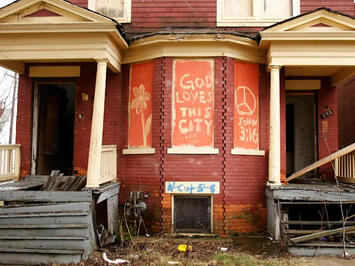
(I know, I know. I haven't been around much lately. My last post was almost six weeks ago. The reasons for my disappearance? A lot of it is life- and work-related, the way things happen with most everyone. However a huge contributor to this is how recent changes in urbanism discourse have played out, and I wonder if there's room for me anymore. Some of my more recent posts can seem like old-guy rants: (What Happened To Addressing Inequality? The Hijacking of Urbanism). I wonder if I'm out of step with today's urbanism, or today's urbanism has moved away from the issues I care about. Whatever it is, I do want to explore that some more. And that will require more regular pieces. I'll start with a repost from April 10, 2022. Later.)
Last weekend, I made my first visit to Houston, Texas to attend a small conference. The event was a gathering of people from around the nation to talk about American cities, with a specific goal of developing ideas to restore the disappearing urban middle class. We had great discussions, lively and informative debates on a wide range of urbanism topics.
Sadly, however, I left the event feeling more irrelevant than in any urbanist discussion before in my life.
I’m from our nation’s middle ground, living within close proximity of two of the five Great Lakes for the vast majority of my life. Yet at this conference, nearly all discussion was shaped by coastal perspectives of American cities, with a healthy dash of how Sun Belt cities, especially Texas ones, offer an affordable alternative. If there was ever any question of whether there’s a strong coastal bias in urbanist discussions, with coastal thinkers and coastal issues controlling the narrative, that notion was quashed.
The gathering was hosted by the Urban Reform Institute, based in Houston. The theme was “Restoring the Middle Class” and included panels discussing a broad range of topics. The first half of the one-day event was devoted to the state of housing in American cities, climate change, energy, transportation and technology impacts on cities. The second half was spent on race and class, the future of urban politics, and the future of community and religion.
The sense of irrelevance arose because of the makeup of the participants, which framed the discussion. A large contingent of current and former Californians were there. The current Californians seemed laser-focused on the impact of stratospheric housing costs on the future of coastal cities, and the homelessness and rising crime that are outcomes of the housing crisis. The former Californians, most of whom had recently relocated to Texas, touted the Texas model of growth as superior to the Golden State’s. There were a number of East Coast representatives, sharing the New York City and Washington, D.C. perspectives of the California issues. And I was the lone voice from the nation’s middle.
On occasion I’d interject and offer a perspective from Chicago, where I live. The Midwest, or Rust Belt, or Heartland, whatever you want to call it, doesn’t have the high housing price tags of the coasts. We don’t have the warm weather that can factor into the corporate decisions that bring new businesses, and therefore new residents, to the Sun Belt. Our region is known for its relative economic stagnation as a result of the loss of manufacturing jobs for the last half century, lagging educational attainment and business formation, and segregation that exacts a tangible cost on economic growth.
I wanted there to be a discussion on policies that could improve all cities – cities that might have an entirely different set of challenges than the coasts or the Sun Belt. I mentioned that from my perspective, what we were discussing were problems related to the success of post-industrial coastal cities over the last 40 years. There’s success in Rust Belt cities, but plenty of failure that prevents the region from fulfilling its economic potential.
Read the rest of this piece at Corner Side Yard Blog.
Pete Saunders is a writer and researcher whose work focuses on urbanism and public policy. Pete has been the editor/publisher of the Corner Side Yard, an urbanist blog, since 2012. Pete is also an urban affairs contributor to Forbes Magazine's online platform. Pete's writings have been published widely in traditional and internet media outlets, including the feature article in the December 2018 issue of Planning Magazine. Pete has more than twenty years' experience in planning, economic development, and community development, with stops in the public, private and non-profit sectors. He lives in Chicago.
Photo: abandoned house in midwestern rust belt. Source: businessinsider.com












